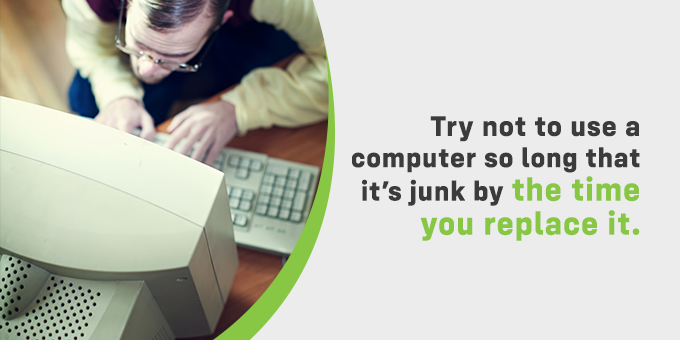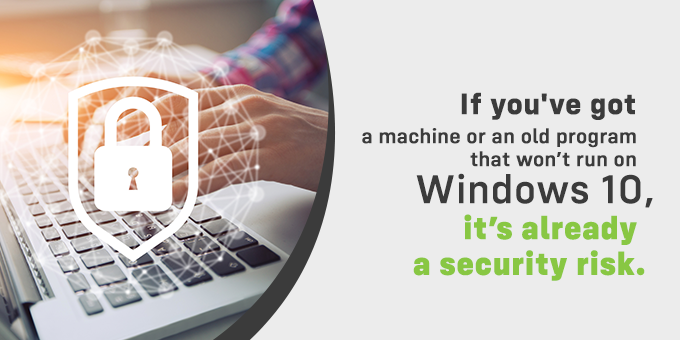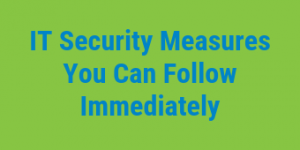(UPDATED 11/12/19)
Microsoft has issued yet another reason for Windows 7 users to upgrade asap. The company will stop supporting Office 365 ProPlus that’s running on Windows 7 on January 14, 2020 — the date on which it stops supporting Windows 7 and Windows Server 8.
This means in about 60 days, Microsoft will stop issuing security patches for those three products, which many SMBs run together. As time goes on, vulnerabilities in that software will inevitably crop up, and they’ll be wide open for hackers to exploit.
Avoid that threat now — especially if your business must comply with cybersecurity regulations. Don’t wait for hackers to create mayhem as they did when Microsoft stopped issuing security patches for Windows XP.

Expect a Bumpy Upgrade If You Don’t Allow Time for Testing
I’ve been urging TechGen clients who are still running these expiring products to upgrade asap. (See “Small Business Dilemma: Should I Upgrade to Windows 10 from Windows 7.”)
Why now? Because we don’t really have until January 14, 2020, to do the upgrade — not if we’re going to do it right.
If you switch over to a new operating system without testing it with your existing software and hardware — and working out any bugs — you could end up scrambling to keep your business running properly after the switchover.
Sometimes only a test run can reveal whether your key software/hardware is compatible with a new operating system like Windows 10. So, leave enough time to test, debug or replace non-compatible hardware/software, and test again before the launch date.
5 Common Mistakes When Upgrading Hardware/Software
In addition to waiting until the “last minute” (which, in this case, it already is), here are some mistakes SMBs make regarding when and how to upgrade their IT infrastructure, devices, and software.
Mistake #1. Not knowing what IT hardware/software you actually have
You’re flying blind if you upgrade your operating system or make other significant IT infrastructure changes without knowing which devices and software the changes will affect.
- Solution: Do a thorough inventory (work with your IT services vendor if you have one) including software version numbers, extended service agreements, hardware serial numbers, and warranties.
The Three Paths to Upgrading from Windows 7 to Windows 10.
Mistake #2. Not replacing hardware before it’s out of warranty
Most business-grade hardware has a three-year warranty. Out-of-warranty equipment can still function well for years with proper upkeep. But you have to weigh potential repair costs and deteriorating performance that may affect productivity and customer service.
- Solution A: Some TechGen clients spread out the cost of replacing machines by leasing them on a three-year cycle, so the PCs are never out of warranty.
- Solution B: Use a spreadsheet and a calendaring tool to set up a reminder system (or outsource this process to your IT services provider). Schedule reminders for when machines near their target retirement date.
Mistake #3: Buying new IT equipment all at once, and then having to replace it all at once
One of the main reasons small businesses end up with equipment that’s too old and prone to slowdowns and breakdowns is that they can’t afford to replace all the machines they need to replace.
- Solution: If you can, replace only a small group of PCs per year. Stagger your purchases so you can budget a fairly steady amount each year for hardware upgrades. (At TechGen, this is part of what we call IT Asset Management.)
Mistake #4: Junking old PCs instead of using them as backup units

Try not to use a computer so long that it’s junk by the time you replace it. For a business, that practice can be more costly than you’d think, as this Forbes article points out very well.
- Solution: If you retire PCs before they completely flame out, you can keep some as emergency backups. It’s best to keep these spares loaded with up-to-date software, so if a key PC goes down unexpectedly, the user can be up and running again quickly.
Mistake #5: Keeping one old machine running on an outdated operating system (like Windows 7 almost is) because it’s running your printer or some other peripheral device
This often happens with SMBs that have a piece of legacy hardware or software that just won’t run on a current operating system. But hackers run automated searches looking for just this type of device, and if it’s connected to your network they can exploit that machine to get inside.
- Solution: First, make sure you look for these stray Windows 7 (or older!) devices when you inventory your IT stuff. Then, replace the hardware or software that won’t run on anything else.
I know that may not be as simple as it sounds. But chances are, if you’ve got a machine or an old program that won’t run on Windows 10, it’s already a security risk.

Upgrade to Stay In Compliance With Cybersecurity Regulations
If your firm is responsible for storing or processing peoples’ sensitive financial data, you already know about your regulatory responsibility to keep that data safe. An outdated operating system is a red flag for industry examiners and auditors.
In addition to risking fines and corrective action by regulators, you’re also facing an increasing risk of getting sued for data breaches (as we’ve been blogging about lately here and here.
Keeping your operating system — along with your hardware and other software — up to date isn’t just a security issue. Outdated tech also affects productivity, employee morale, responsiveness to customers, and ultimately your ability to compete.
So don’t think of replacing Windows 7 and/or Windows Server 2008 as upgrading software — think of it as upgrading your business. For another take on the upgrade options, check out this post by our friends Aligned Technology Solutions.


